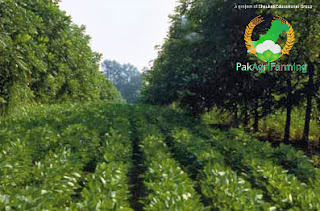There
are a number of different purposes and uses of the crops. The crops and cropping systems can be classified in a number of different ways based on a long list of categories. Previously we have discussed 'Botanical classification of plants' and 'Agronomic Use classification of the crops'. Now, we will discuss a classification of crops based on their use in the field in different cropping systems;
 |
| Crop Classification based on Purpose in field (article cover) |
1.
Catch crops or Contingent Crops
Catch
crops are cultivated in the field to catch the forthcoming season. The main
reason for their plantation is that the main crop has failed in the field due
to any biotic or abiotic stress. Hence, these crops are cultivated in the field
for a number of reason;
à They are fast growth rate and
short duration crops.
à They can be easily harvested
or used in the field at any desired time (for example, as green manure).
à They are easily adaptable to
the season, soil and farm management practices.
Advantages
à Provide feed for animals
à Act to reduce or check the
weed growth
à Conserve soil, moisture and
fertilizers.
Examples: Chickpea,
cowpea, onion, bajra, coriander and onion.
 |
| Chickpea field |
2.
Restorative Crops
Restorative
crops are known for their positive impact on the soil since they add organic
matter to soil as well as root nodules in the roots of these crops fix
atmospheric nitrogen into nitrates and nitrites in the soil and thus enhance
the fertility of such soils. The plants also have a habit of shedding their leaves
while reaching maturity and add more nutrients to soil. These crops also have
produce good and economic yields.
Example: all
leguminous crops such as lentils, mung, mash, cowpea.
 |
| Lentil Crop |
3.
Exhaustive Crops
Exhaustive
crops are known for consuming the soil contents more aggressively and hence
after the harvest the soil is said to have been ‘exhaustive’ and require a lot
of fertilizer addition (both organic and chemical fertilizers).
Examples: Sunflower,
eggplant (brinjal) and linseed (alsi).
 |
| Brinjal Plant |
4.
Residual or Paira Crops
Residual
crops are called so because their purpose is to utilize the moisture in the
field left when the previous crop is near harvest. So these crops are sown in
the fields without preparatory tillage with the near harvest crop. This
practice is also known as ‘relay cropping’ since it is just like relay race,
when a running partner hands over the torch to next partner on the track.
Similarly, both crops here are also on the same field for some time.
Examples: cultivation
of pulses (lentil, chickpea etc.) in the paddy fields to conserve moisture.
5.
Cover crops
Cover
crops are known for their potential to hold the soil particles together to
protect against soil erosion through wind and water. These plants protect the
soil either through ground covering foliage or root mats which do not let the soil
particles to conserving soil texture and protecting soil structure.
Examples: groundnuts,
chickpea and sweet potato.
6.
Barrier or Guard crops
Barriers
crops are plants/trees which are sown along the edge of the fields, or plots to
protect the main crop from the harms of intensity of wind or against
trespassing.
Examples: safflower
around chickpea, sorghum around cotton and mesta around sugarcane.
7. Alley
Crops
Alley
crops are called so because these are planted in the ‘alleys’ created between
plantations of trees or shrubs. Their main purpose is the restoration of soil
fertility and reduction of soil erosion. Their growth is usually not stopped by
the shade of these trees and shrubs.
Examples: growing
pulses between trees of Casuarina.
 |
| Alley cropping |
8. Smother
Crops
The
word ‘smother’ means ‘to kill’. These crops are called so because of their
ability to check weed growth because of their quick growth, dense foliage and
heavy tillering or trailing habit.
Examples: cowpea,
mustard and barley.
9. Nurse
Crops
These
are the crops which are cultivated along main crops in the field and their
function is to enhance or maintain the fertility in the soil or fix the
atmospheric nitrogen because they have root nodules.
Examples: some legume
crop incorporated with cereals.
 |
| Legume intercropping in Wheat field |
10.
Trap Crops
These
are crops grown in the fields of main crops for trapping the harmful insects,
nematodes or weeds.
Examples: nematodes
are trapped by the roots of solanaceous crops and the nematodes can be removed
when these trap crops are uprooted from the field. Similarly, castor incorporated
in cotton and groundnut act as trap crop for army worm pest.

